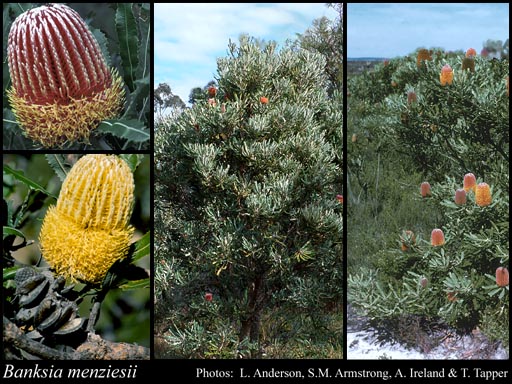- Reference
- Prodr. Suppl. 36 (1830)
- Conservation Code
- Not threatened
- Naturalised Status
- Native to Western Australia
- Name Status
- Current
Tree or shrub, 1.3-7 m high, usually arising from lignotuber or epicormic buds. Fl. pink/red/yellow, Feb to Oct. White, grey or yellow sand.

Scientific Description
Trees, 2-8 m high; branchlets glabrous or hairy. Leaves petiolate, alternate, 140-250 mm long, 18-40 mm wide, hairy; petiole 10-25 mm long; lamina flat, more or less the same width throughout, once divided, pinnately divided, shallowly divided, teeth pointing outwards, with 23-42 lobes on each side, the margins flat. Inflorescences tomentose (with matted or tangled, soft, woolly hairs), yellow or red; innermost bracts 6-8 mm long, hairy. Perianth 26-33 mm long, hairy, all over, limb apex pubescent (with soft, straight, erect hairs) or silky (with soft, shiny and appressed hairs), without awns; pistil 34-42 mm long, curved, style hairy or glabrous. Follicles hairy, pubescent (with soft, straight, erect hairs), obovate, 25-35 mm long. Flowers in February, March, April, May, June, July, August, September or October. Occurs in the South-west (SW) Botanical Province(s), in the Geraldton Sandplains (GS), Swan Coastal Plain (SWA), Avon Wheatbelt (AW) or Jarrah Forest (JF) IBRA subregion(s).
Distribution
- IBRA Regions
- Avon Wheatbelt, Geraldton Sandplains, Jarrah Forest, Swan Coastal Plain.
- IBRA Subregions
- Dandaragan Plateau, Geraldton Hills, Katanning, Lesueur Sandplain, Merredin, Northern Jarrah Forest, Perth.
- Local Government Areas (LGAs)
- Armadale, Bayswater, Belmont, Beverley, Cambridge, Carnamah, Chapman Valley, Cockburn, Coorow, Dandaragan, Fremantle, Gingin, Goomalling, Gosnells, Irwin, Joondalup, Kalamunda, Kwinana, Mandurah, Melville, Murray, Nedlands, Northampton, Perth, Rockingham, Serpentine-Jarrahdale, South Perth, Swan, Three Springs, Victoria Plains, Wanneroo, York.